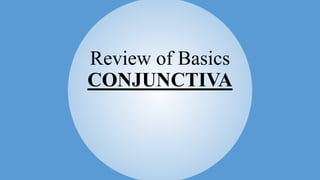
conjunctiva.pptx
- 2. Introduction • The conjunctiva is a mucous membrane consisting of loose, vascular connective tissue. • It is transparent. • Its transparency is less than that of the cornea when observed with a slit-lamp. • Is loose, to allow free and independent movement of the globe. • Is thinnest over the underlying Tenon's capsule.
- 3. Parts of conjunctiva • The conjunctiva can be divided into three sections that are continuous with one another: • (1) the tissue lining the eyelids is the palpebral conjunctiva, or tarsal conjunctiva; • (2) the bulbar conjunctiva covers the sclera; and • (3) the conjunctival fornix is the cul-de- sac connecting palpebral and bulbar sections
- 4. Cul-de-sac Its continuous with • the lining of the globe beyond the cornea the upper and lower fornices • the innermost layer of the upper and lower eyelids • • the skin at the lid margin • the corneal epithelium at the limbus • the nasal mucosa at the lacrimal puncta • The cul-de-sac normally holds 7µl of tear fluid but has the capacity to accommodate fluid up to 30 µl Whitnall & Ehlers, 1965
- 5. Layers of conjunctiva Microscopically conjunctiva consists of three layers- epithelium, adenoid layer, and a fibrous layer.
- 6. Conjunctival Epithelium Conjunctiva Number of layers Cells in the layers Marginal 5 layered non- stratified squamous epithelium Superficial layer: cells Middle three layers: cells Deepest layer: Tarsal 2 layers of Stratified epithelium Superficial layer: Deepest layer: cuboidal Fornix and bulbar 3 layers of Stratified, epithelium Superficial layer: Middle layer: polyhedral Deepest layer: Cuboidal Limbal 10 layers of stratified epithelium Superficial layer: Middle layer: polygonal Basal- cubical Other than squamous epithelial cells • Goblet cells- 10-20 µm in size, arise from basal layer, secretes mucin • Langerhans cell- dendritic immune cells AKA Birbeck granule • Melanocytes – secretes melanin
- 7. Substantia propria or conjunctival submucosa • It consists of a superficial lymphoid layer and a deeper fibrous layer • This tissue has enormous anti-infectious potential. Numerous mast cells (6000/mm3), lymphocytes, plasma cells, and neutrophils are normally present in this layer • Lymphoid layer – CALT(Conjunctiva Associated Lymphoid Tissue) consists of T & B lymphocytes • Mast cells- Mast cells are granulocytic cell-like basophils.coated with IgE antibody. The contents of the mast cell act like mediators of allergic reactions.
- 8. Fibrous layer • This layer contains the vessels and nerves of conjunctiva and aqueous secreting glands • Protects deeper layers Accessory lacrimal glands like glands of Krause & Wolfring are situated in this layer
- 9. Blood supply
- 10. Nerve supply
- 12. Age related changes in conjunctiva Pinguecula Definition Harmless grayish yellow thickening of the conjunctival epithelium in the palpebral fissure. Epidemiology: Pinguecula are the most frequently observed conjunctival changes. Etiology: The harmless thickening of the conjunctiva is due to hyaline degeneration of the subepithelial collagen tissue. Advanced age and exposure to sun, wind, and dust foster the occurrence of the disorder. Symptoms: Pinguecula does not cause any symptoms. Diagnostic considerations: Inspection will reveal grayish yellow thickening at 3 o’clock and 9 o’clock on the limbus. The base of the triangular thickening (often located medially) will be parallel to the limbus of the cornea; the tip will be directed toward the angle of the eye Differential diagnosis: A pinguecula is an unequivocal finding. Treatment: No treatment is necessary. Only in cosmetic considerations
- 13. Pterygium Definition Triangular fold of conjunctiva that usually grows from the medial portion of the palpebral fissure toward the cornea. Epidemiology: Pterygium is especially prevalent in southern countries due to increased exposure to intense sunlight. Etiology: Histologically, a pterygium is identical to a pinguecula. However, it differs in that it can grow on to the cornea; also this encroachment is thought to be a preventive measure to save the cornea, the gray head of the pterygium will grow gradually toward the center of the cornea. This progression is presumably the result of a disorder of Bowman’s layer of the cornea, which pro-vides the necessary growth substrate for the pterygium. Symptoms and diagnostic considerations: A pterygium only produces symptoms when its head threatens the center of the cornea and with it the visual axis. Tensile forces acting on the cornea can cause severe corneal astigmatism. A steadily advancing pterygium that includes scarred conjunctival tissue can also gradually impair ocular motility; the patient will then experience double vision in abduction. Differential diagnosis: A pterygium is an unequivocal finding. Treatment: Treatment is only necessary when the pterygium produces the symptoms discussed above. Surgical removal is indicated in such cases. The head and body of the pterygium are largely removed, and the sclera is left open at the site. The cornea is then smoothed with a diamond reamer or an excimer laser (a special laser that operates in the ultraviolet range at a wavelength of 193 nm). • Conjunctival graft is also used to prevent recurrence.
- 14. General age related changes In old age, changes to the eye may include the following: • Yellowing or browning of the conjunctiva caused by many years of exposure to ultraviolet light, wind, and dust • Thinning of the conjunctiva •Overall dryness or loss of lustre of mucosal membrane of conjunctiva
- 15. References: • Shumway CL, Motlagh M, Wade M. Anatomy, Head and Neck, Eye Conjunctiva. [Updated 2022 Aug 30]. In: StatPearls [Internet]. Treasure Island (FL): StatPearls Publishing; 2023 Jan-. Available from: https://www.ncbi.nlm.nih.gov/books/NBK519502/ • Histological, immunohistochemical and clinical considerations on amniotic membrane transplant for ocular surface reconstruction - Scientific Figure on ResearchGate. Available from: https://www.researchgate.net/figure/Microscopic- aspect-of-bulbar-conjunctiva-stratified-squamous-epithelium-situated-on_fig1_319332604 [accessed 26 Apr, 2023] • Knop E, Knop N. The role of eye-associated lymphoid tissue in corneal immune protection. J Anat. 2005 Mar;206(3):271-85. doi: 10.1111/j.1469-7580.2005.00394.x. PMID: 15733300; PMCID: PMC1571473. • Adler’s physiology of the eye • Clinical anatomy & physiology of the visual system, Lee Ann Remington